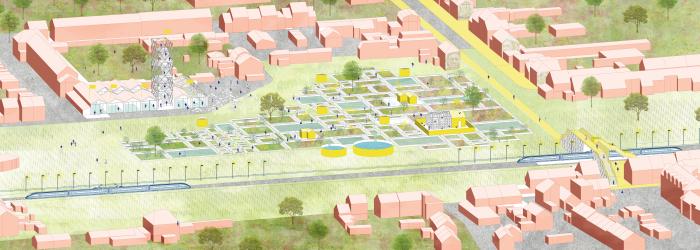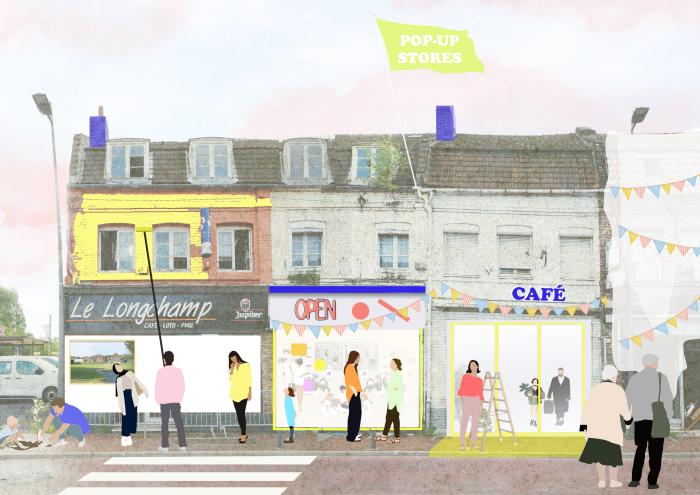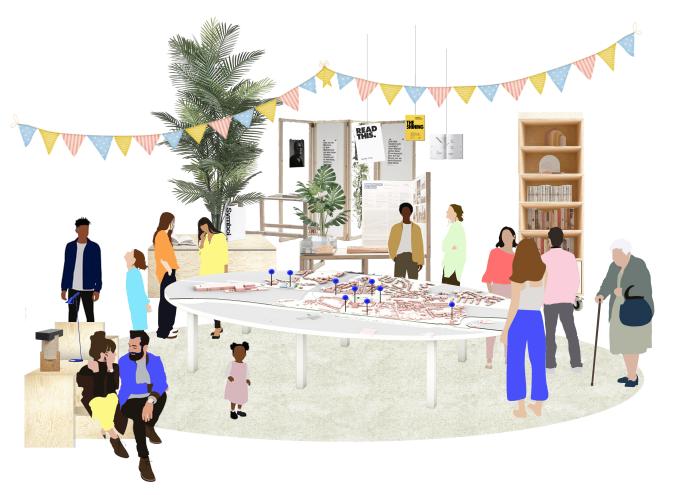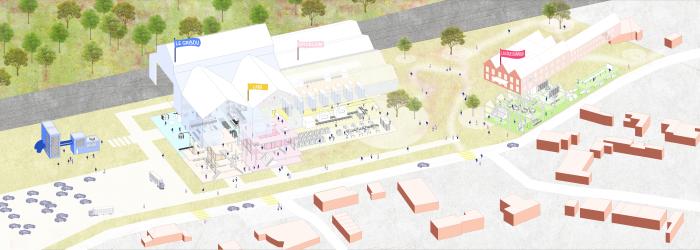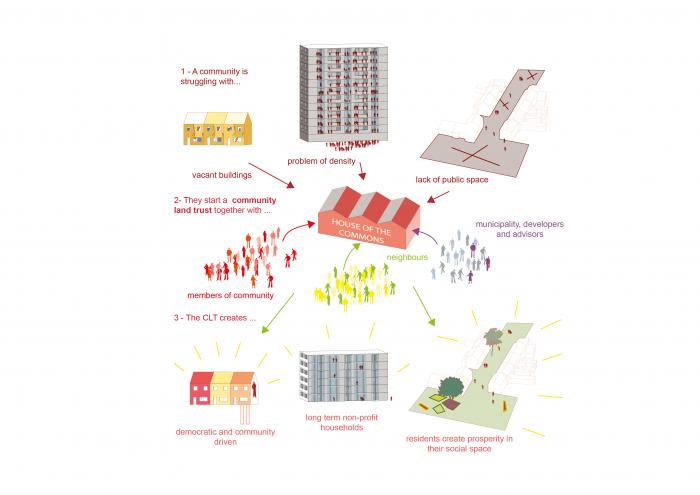The greater Douais, as with all post-industrial areas, is a forgotten urban fabric awaiting a fresh start. If the term “degrowth” often describes the image of an area in decline, it is also a substantial keyword to sustainability! Therefore, Breeding Ground is inspired by a positive and sustainable degrowth, embed in a territory capable of change, and allowing smart densification and profound economic changes. Above all, applying circular tools can sprout a new commons called resilience.
Dorignies
Flers-en-Escrebieux
Region Nord Pas de Calais
The concept of “Shrinking Cities” was born in Germany at the beginning of the 2000s, with the proof of the effects of the Wende on the economic and demographic growth of the cities of the Eastern Germany. In France, Dorignies and Flers are part of this decrease mainly because their prosperity was based on a mono-economy: coal mining was not only a source of big economic and demographic growth, but also the cornerstone of a life- quality and a social utopia.
Fourteen years after the closure of the coal mines, those parts of the city are still experiencing a decline in both their population and their economic attractiveness. The high rate of unemployment, the lack of public spaces and facilities, of jobs and of income enclose the area and isolate the population.
If shrinking cities appear as direct results of the end of the coal crisis, they are certainly the breeding grounds for a new metabolism based on circularity and sustainability. The industrial past has shaped the architecture and the urban planning of these spaces, revealing large wastelands and strong infrastructures. These components are nowadays perceived as fractures and scars of the city. Yet, the existence of waterways, railways and urban voids hold the potential to be a substantial wealth for the territory, allowing intelligent densification and profound economic changes.
Working in the regions of Dorignes and Flers, Breeding Ground proposes a new way of interacting with this existing industrial landscape, interrupting the narrative of decline through a series of socially and ecologically sustainable interventions.
Please highlight how the concept/idea can be exemplary in this context
If the term “degrowth” often describes an image of an area in decline, it is also a substantial keyword to sustainability. Therefore Breeding Ground is inspired by a positive and sustainable degrowth. The vacant and sparse urban fabric of Doriginies and Flers offers us capable spaces: they are able to host a wide variety of programs and substantially accelerate new forms of economy.
Vacant spaces, time of the inhabitants, energy resources and lack of jobs are the driving forces behind a rapid transition of economic and social practices. Therefore we must consider this decrease as an opportunity to re-invent these neighbourhoods. The economic development of the area, still based on fossil resources (zinc for example) seems still weakened. Breeding Ground aims to be the driving forces for a new economy based on sustainable energies and social vitalities. The exploitation of Methane, but also of renewable materials such as the cultivation of mycelium are keys for the new economy. In the meantime a transition from the social housing park (renting) to a community land trust system will bring a new lease of life to the city. These proposals are based on low investments relying on existing infrastructure, such as transport (canal and railroad), mine galleries or garden cities. Building a renewable city means rethinking a social economy, embedded in the territory and meeting its needs: space, roof, energy, food and social interactions.
Please highlight how the concept/idea can be exemplary in this context
In this proposal we looked for a clear, fast and efficient growing system for the urban fabric. Because of the urgency of the needs, we have chosen to develop with the different actors the following method : to plant - to cultivate - to pollinate.
Inclusivity, metabolism and the project site are strongly connected to each other if you find the common denominator. So what are those denominators? Economy, education and social interaction. The site asked for an overall strategy, we created by connecting the waterway with the railway. These points of interest were strengthened by creating an economy on both ends, a shopping street at the tracks and a floating market on the river. In between the two a lush garden is made to provide food, education and jobs. On the other side of the highway a big area for enterprises is available. This area is designated for the larger scale of the revitalisation of Douai, making the city sustainable. The community house and the CLT are created to provide the social framework. At the end, Breeding Grounds wish to be an exemplar way of re-cultivating cities, by looking for new tools carried by the community.
Please highlight how the concept/idea can be exemplary in this context
The collective memory written by the mining past reveals existing social mechanisms based on a will-to-do and a capability to reinvent itself. Sharing, mutual aid, and social structure have been the core of the urban fabric of these mining districts. The closure of the mines has forced these territories to renew themselves and despite a national desire to regenerate an economy, these territories reveal a nostalgia and an immense need for revitalisation. What if the collective memory of mines was the ground for a new social economy? In this way, the mines wealth of the past will become the energy of tomorrow. Polluted land will be the site of new know-how and shared agriculture. The practical school will train professionals on circular know-how, inviting sustainable materials and energies. Dorignies and Flers will base their metabolism on a Community Land Trust in response to the old garden cities. The inhabitants will be the actors and the protectors of these possible spaces, where time and learning will be valued as much as generating economy. These new vitalities will be sources of sharing and social revitalisation.
Please highlight how this approach can be exemplary
MAKE DO - FAIRE AVEC
Make Do is the cornerstone of the project. It means building with the community, the resources and the available space. The process will urge to think-up , to locate, to program and to activate before starting building. Inhabitants, municipalities and design teams must create a tool box in order to weave the vital synergy between programs and needs. Breeding ground symbolises the growth of a territory rich in knowledge, time, resources and landscape. Therefore, the process is based on the logic of farming (to plant/ to cultivate/ to pollinate) generating the vital needs for the community. At the heart of the process, clear project phases must be established, starting with a first vital intervention: the permanent lab or house of the Commons. This phase 1, “to plant” responds to the urgency and the need to start revitalisation tomorrow. A strong activation process can allow the fast implementation of the project in a modest and evolving economic framework. The involvement of the community is at the heart of this process. The second phase, “to cultivate”, aims to engage projects on a larger-scale. Directly inspired by the first phase of activation, these urban interventions are established in a lasting and permanent manner. They will become the perennial components of the Douaisis. The third phase “to pollinate” marks the clear transition towards a deep urban renewal made possible by a new economy. The impact of this profound revitalisation will attract and produce a growing economy enhancing the urban and social renewal.
CLT : COMMUNITY LAND TRUST
Breeding Ground uniquely proposes to establish the local area as a Community Land Trust - a cooperation which combines the individual ownership of assets (housing, collective space) with a collective ownership of land.
The concept of a CLT is based on connecting three ideas:
- Ground and materials
- Use (Housing, Agriculture, Public space, etc.)
- Community
The goal is to have long term benefit for the community in regards of ecology, inclusivity and economy.
A CLT is run by the community, they own together the land and decide what the people need. It follows 10 key values:
Non profit
- Dual ownership: ground of the trust, buildings of the trustees
- Ground leasing with the CLT als guarantee for the long term
- Payable, if an owner change the price stays fair
- Permanent responsibility of the ground
- Local participation, the inhabitants have the right to vote.
- Local control, 2⁄3 of the board are inhabitants.
- Triparty organisation, represantation of 1⁄3 owners, 1⁄3 area, 1⁄3 government - Focus on sustainable growth by local embedding
- Flexible development
LA MAISON DE LA COMMUNE - a space to cultivate
ACTIVATING
The House of the commons is located next to the existing centre culturel de Dorignies creating a social hub. Therefore the house of the commons becomes the main centre for the making of the urban fabric. This place will invite a co-creating process in order to design the future programme and spaces of the area. The collective action is essential in order to generate a new metabolism. The social link is embedded in the collective design binding different range of ages. The architecture of the space stand out by its program, therefore it offers capable spaces hosting mixed uses.
1- Mixed use hall
2- Physical model of the area
3- ideas labs
4- Information display and advertising of the urban transformation.
5- Winter gardens
A PLACE TO LEARN AND SHARE
An inclusive process can be generate by local actors or temporary residence of architects, urbanists and landscape designers. The temporary lab will help to design tools and activate the first intervention to transform the neighborhoods. Further, the mixed use hall will be used as an event space but also communities brainstorming. The making of a physical model will help to map and located the micro actions necessary to revitalize the area. The Community Land trust will begins thanks to the house of the commons framework.
LEARNING AND WORKSHOP
The community house is an active space which host and organize learning workshops. By creating social intensity and offering learning classes to people in career change or seeking for a job it is essential to give the right tools. Knowledge is an economic value and can provide growth and transformation to cities. Therefore the community house would also be a place to train and support people in looking for a job. Advices and mentorship could encourage this search for jobs.
In the immediate term, the funding from the New European Bauhaus prize would allow local research and social investment, with a pilot project to initiate the local Community Land Trust. The CLT could begin to work towards the first stage of Urban Revitalisations:
POP-UP STORES
The amount of vacant buildings is high in the area. These spaces can be easily refurbished with a lick of paint. While the CLT works to creates longer-term plans for the spot, the space of a shop can be used to test out its concept. If successful, it can stay in place or relocate within the community.
SOCIAL FOOD
The vacant spaces are a perfect place to produce food. Via the CLT, a food ecosystem can start, to harvest, grow and share. Harvesting is done by collecting compost, which is stored in worm hotels. The worms create sirup for the plants, food for the chickens and food for the fish. The food is grown and distributed to the social restaurant, the watermarket and all the community members. By providing households with food, their expense on households are less, thus generating income for economic growth.
CHATEAU DELATTRE
A refurbishment is needed on the tower. The height is not fitting the area nor the high density. The plinth will be opened and the facade will be extended with a winter-garden. The existing windows frames will be replaced by big entrees to open up the garden according to the climate.
REFURBISHMENTS OF THE SOCIAL HOUSING
Together with the inhabitants, the old miners houses will be refurbished. Because of their repetitive design, a new extension framework is added with the necessary upgrade in MEP. The inhabitants will create/design their own infill.
@Barriol Estelle, 2022
Content licensed to the European Union.
